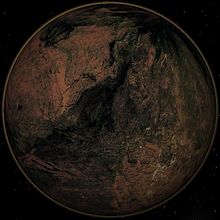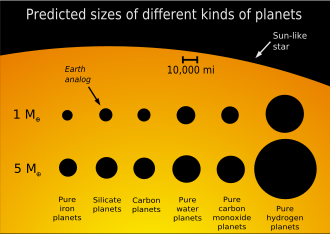"Diamond planet" redirects here. For the planet nicknamed "the Diamond Planet", see 55 Cancri e.

A carbon planet is a hypothetical type of planet that contains more carbon than oxygen. Carbon is the fourth most abundant element in the universe by mass after hydrogen, helium, and oxygen.
Marc Kuchner and Sara Seager coined the term "carbon planet" in 2005 and investigated such planets following the suggestion of Katharina Lodders that Jupiter formed from a carbon-rich core. Prior investigations of planets with high carbon-to-oxygen ratios include Fegley & Cameron 1987. Carbon planets could form if protoplanetary discs are carbon-rich and oxygen-poor. They would develop differently from Earth, Mars, and Venus, which are composed mostly of silicon–oxygen compounds. Different planetary systems have different carbon-to-oxygen ratios, with the Solar System's terrestrial planets closer to being "oxygen planets" with C/O molar ratio of 0.55. In 2020, survey of the 249 nearby solar analog stars found 12% of stars have C/O ratios above 0.65, making them candidates for the carbon-rich planetary systems. The exoplanet 55 Cancri e, orbiting a host star with C/O molar ratio of 0.78, is a possible example of a carbon planet.
Definition
Such a planet would probably have an iron-rich core like the known terrestrial planets. Surrounding that would be molten silicon carbide and titanium carbide. Above that, a layer of carbon in the form of graphite, possibly with a kilometers-thick substratum of diamond if there is sufficient pressure. During volcanic eruptions, it is possible that diamonds from the interior could come up to the surface, resulting in mountains of diamonds and silicon carbides. The surface would contain frozen or liquid hydrocarbons (e.g., tar and methane) and carbon monoxide. A weather cycle is hypothetically possible on carbon planets with an atmosphere, provided that the average surface temperature is below 77 °C.
However, carbon planets will probably be devoid of water, which cannot form because any oxygen delivered by comets or asteroids will react with the carbon on the surface. The atmosphere on a relatively cool carbon planet would consist primarily of carbon dioxide or carbon monoxide with a significant amount of carbon smog.
Composition

Carbon planets are predicted to be of similar diameter to silicate and water planets of the same mass, potentially making them difficult to distinguish. The equivalents of geologic features on Earth may also be present, but with different compositions. For instance, the rivers might consist of oils. If the temperature is low enough (below 350 K), then gasses may be able to photochemically synthesize into long-chain hydrocarbons, which could rain down onto the surface.
In 2011, NASA cancelled a mission called TPF, which was to be an observatory much bigger than the Hubble Space Telescope that would have been able to detect such planets. The spectra of carbon planets would lack water, but show the presence of carbonaceous substances, such as carbon monoxide.
Possible candidates
Draugr, Poltergeist and Phobetor
The pulsar planets Draugr, Poltergeist and Phobetor may be carbon planets that formed from the disruption of a carbon-producing star. Carbon planets might also be located near the Galactic Center or globular clusters orbiting the galaxy, where stars have a higher carbon-to-oxygen ratio than the Sun. When old stars die, they spew out large quantities of carbon. As time passes and more and more generations of stars end, the concentration of carbon and carbon planets, will increase.
Janssen
In October 2012, it was announced that Janssen showed evidence for being a carbon planet. It has eight times the mass of Earth and twice the radius. Research indicates that the 2,150 °C (3,900 °F) planet is "covered in graphite and diamond rather than water and granite". It orbits the star Copernicus once every 18 hours.
Other carbon-rich objects
In August 2011, Matthew Bailes and colleagues from Swinburne University of Technology in Australia reported that the millisecond pulsar PSR J1719-1438 may have a binary companion star that has been crushed into a much smaller planet made largely of solid diamond. They deduced that a small companion planet must be orbiting the pulsar and causing a detectable gravitational pull. Further examination revealed that although the planet is relatively small (60,000 km in diameter, or five times bigger than the Earth) its mass is slightly more than that of Jupiter. The high density of the planet gave the team a clue to its likely makeup of carbon and oxygen—and suggested the crystalline form of the elements. However, this "planet" is hypothesized to be the remains of an evaporated white dwarf companion, being only the remnant inner core. According to some definitions of planet, this would not qualify because it formed as a star.
At a distance of 267+1.2
−0.9 pc (approximately 870 light-years), PSR J2222−0137 is a nearby intermediate-mass binary pulsar whose low-mass neutron star's companion is a white dwarf (PSR J2222−0137 B). The white dwarf has a relatively large mass of 1.319 ± 0.004 M☉ and a temperature less than 3,000 K, meaning it is likely crystallized, leading to this Earth-sized white dwarf being described as a "diamond-star".
Brown dwarfs
Planets around brown dwarfs are likely to be carbon planets depleted of water.
See also
- Extraterrestrial diamonds
- Helium planet, another form of mass-lost white dwarf becoming a planet
- Iron planet
- Ocean planet
- WASP-12b
- WASP-103b
References
- Kuchner, Marc J.; Seager, S. (2005). "Extrasolar Carbon Planets". arXiv:astro-ph/0504214.
- Lodders, Katharina (2004). "Jupiter Formed with More Tar than heat" (PDF). The Astrophysical Journal. 611 (1): 587–597. Bibcode:2004ApJ...611..587L. doi:10.1086/421970. S2CID 59361587.
- Fegley, Bruce Jr.; Cameron, A. G. W. (April 1987). "A vaporization model for iron/silicate fractionation in the Mercury protoplanet" (PDF). Earth and Planetary Science Letters. 82 (3–4): 207–222. Bibcode:1987E&PSL..82..207F. CiteSeerX 10.1.1.667.7941. doi:10.1016/0012-821X(87)90196-8.
- P. E. Nissen, The carbon-to-oxygen ratio in stars with planets
- Stonkutė, E.; Chorniy, Y.; Tautvaišienė, G.; Drazdauskas, A.; Minkevičiūtė, R.; Mikolaitis, Š.; Kjeldsen, H.; Essen, C. von; Pakštienė, E.; Bagdonas, V. (2020). "High-resolution Spectroscopic Study of Dwarf Stars in the Northern Sky: Lithium, Carbon, and Oxygen Abundances". The Astronomical Journal. 159 (3): 90. arXiv:2002.05555. Bibcode:2020AJ....159...90S. doi:10.3847/1538-3881/ab6a19. S2CID 211096705.
- Teske, Johanna K.; Cunha, Katia; Schuler, Simon C.; Griffith, Caitlin A.; Smith, Verne V. (2013). "Carbon and Oxygen Abundances in Cool Metal-Rich Exoplanet Hosts: A Case Study of the C/O Ratio of 55 Cancri". The Astrophysical Journal. 778 (2): 132. arXiv:1309.6032. Bibcode:2013ApJ...778..132T. doi:10.1088/0004-637X/778/2/132. S2CID 119291907.
- Musser, George (January 2010). "Earth-Like Planets May Be Made of Carbon". Scientific American. Retrieved 3 January 2013.
- "Kohlenstoffplaneten", Space Magazin April 2014 (p. 35, in German)
- Naeye, Bob (24 September 2007). "Scientists Model a Cornucopia of Earth-sized Planets". Goddard Space Flight Center.
- Seager, Sara; Kuchner, Marc; Hier-Majumder, Catherine; Militzer, Burkhard (2007). "Mass-Radius Relationships for Solid Exoplanets". The Astrophysical Journal. 669 (2): 1279. arXiv:0707.2895. Bibcode:2007ApJ...669.1279S. doi:10.1086/521346. S2CID 8369390.
- "Carbon Planets - Space Art and Astronomical Illustrations". Novacelestia.com. Retrieved 3 January 2013.
- Wickham, Chris (15 October 2012). "A diamond bigger than Earth?". Reuters. Archived from the original on 5 March 2016. Retrieved 3 January 2013.
- "Solid diamond planet found". Australian Geographic. 26 August 2011. Archived from the original on 6 October 2011.
- Lemonick, Michael (26 August 2011). "Scientists Discover a Diamond as Big as a Planet". Time. Archived from the original on 26 August 2011.
- ^ Kaplan, David L.; Boyles, Jason; Dunlap, Bart H.; Tendulkar, Shriharsh P.; Deller, Adam T.; Ransom, Scott M.; McLaughlin, Maura A.; Lorimer, Duncan R.; Stairs, Ingrid H. (2014). "A 1.05M☉Companion to PSR J2222–0137: The Coolest Known White Dwarf?". The Astrophysical Journal. 789 (2): 119. arXiv:1406.0488v1. Bibcode:2014ApJ...789..119K. doi:10.1088/0004-637X/789/2/119. ISSN 0004-637X. S2CID 19986066.
- Guo, Y. J.; Freire, P. C. C.; Guillemot, L.; Kramer, M.; Zhu, W. W.; Wex, N.; McKee, J. W.; Deller, A.; Ding, H.; Kaplan, D. L.; Stappers, B.; Cognard, I.; Miao, X.; Haase, L.; Keith, M.; Ransom, S. M.; Theureau, G. (2021). "PSR J2222−0137. I. Improved physical parameters for the system". Astronomy & Astrophysics. 654: A16. arXiv:2107.09474. Bibcode:2021A&A...654A..16G. doi:10.1051/0004-6361/202141450. S2CID 236134389.
- Drake, Nadia (24 June 2014). "Astronomers Find Slow-Cooked Diamond the Size of Earth". National Geographic. Archived from the original on 21 March 2021.
- Pascucci, Ilaria; Herczeg, Greg; Carr, John S.; Bruderer, Simon (December 2013). "The atomic and molecular content of disks around very low-mass stars and brown dwarfs" (PDF). The Astrophysical Journal. 779 (2): 178. arXiv:1311.1228. Bibcode:2013ApJ...779..178P. doi:10.1088/0004-637X/779/2/178. hdl:11858/00-001M-0000-0017-AAEA-0. S2CID 119001471.
- Than, Ker (7 June 2006). "Star's Planets Might Have Mountains of Diamonds". Space.com.
| Exoplanet search projects | |||||||||||
|---|---|---|---|---|---|---|---|---|---|---|---|
| Ground-based |
|   | |||||||||
| Space missions |
| ||||||||||
| Related | |||||||||||
